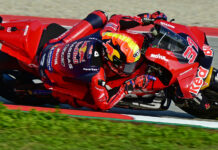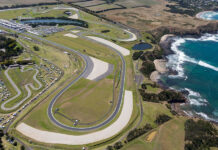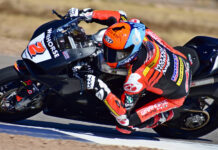DAYTONA BEACH, FL – The opening round of the 2011 AMA Pro Road Racing season featured some of the most intense, unforgettable action the series has seen yet. It also featured difficult decisions, outright failures, and confusion and dismay among fans and participants, out of respect for whom AMA Pro Racing pens this lengthy release. The decisions made last weekend will be explained here in detail; the failures that occurred will be acknowledged and addressed. As is common knowledge at this point, AMA Pro Racing’s spec-tire partner, Dunlop, saw evidence of front-tire overheating in the aftermath of many Daytona 200 riders’ first pit stops. Once a conclusion was reached, they immediately notified AMA Pro officials that in the interests of rider safety, the Daytona 200 would need to be stopped long enough to allow all participating riders to mount a fresh front tire, and the red flag was thrown within ten seconds of that communication. The length of the downtime that followed has led to significant speculation about several aspects of the day’s events; the actual facts are detailed below. Additional background: Initially, Dunlop advised AMA Pro that riders would need to swap their current fronts for fresh versions of the same tire before continuing the 200, and the paddock was instructed to do so. Once riders were pitted under the red flag, however, Dunlop reassessed the situation and decided, again in the interests of safety, that all riders would need to be fitted with entirely new-spec backup fronts then stored in Dunlop’s garages. The execution of both Dunlop decisions were complicated (and lengthened) by the fact that many teams had neither extra fronts (relating to the first set of instructions), nor extra rims. LENGTH OF THE RED-FLAG HOLD: The length of the downtime that followed the first red flag was wholly and solely dictated by the amount of time it took to get each of the thirty-eight Daytona 200 competitors re-fitted with new-spec tires that were warmed long enough to be safely raced on. The downtime included the paddock’s attempts to comply with original instructions, the communication to the paddock of Dunlop’s revised assessment, the process of getting the entire field’s front rims re-fitted with new-spec rubber, and the time it took to safely warm new tires. Dunlop’s new-spec re-fitment process was non-stop. During this period, AMA Pro re-set the Daytona 200 re-start time several times based on communication with Dunlop about their progress. LTD Racing’s Huntley Nash was the last rider in the class to receive a new tire, and in consultation with Nash’s crew chief, Gary Medley, it was decided that 20 minutes was the minimum amount of time his tire needed to warm. The 3-minute board for the race’s re-start was set for 20 minutes from that time. TEAM LATUS RACING/JASON DISALVO: Because Team Latus Racing used the significant red-flag downtime to repair eventual race-winner Jason DiSalvo’s Ducati machine, speculation has given rise to two rumors that will be addressed here: 1) That the red-flag hold was extended to give Latus time to re-enter the race; 2) That the Latus machine was out of AMA Pro’s control at points during said downtime. 1) The most straightforward response to Item 1 can be found in the above paragraphs detailing how the red flag and restart occurred and were handled. In short, the length of the red flag was solely dictated by the time it took to safely address the tire problem. To that fact, AMA Pro would simply add that we are fiercely dedicated to treating all of our participating teams and manufacturers equally and fairly, and further, that the matter of our dwindling live TV time—- the importance of putting our series in front of a live, prime-time audience—- was also of great importance. There was no benefit to AMA Pro in a red track; only in a green one. 2) Once pitted, Latus staff asked AMA Pro officials the approximate length of the red flag. As the extent of the tire problem was not clear at that point, they were told 10 minutes. AMA Pro grid official Mike Lagenfeld asked the Latus team to move DiSalvo’s machine from pit lane to behind the wall, as it was deemed to be in an unsafe position for the then-impending restart. From that point on, the Latus machine was at no time out of Mr. Lagenfeld’s sight; Lagenfeld also periodically monitored both team and machine for 3- to 5-minute intervals. When Lagenfeld informed the Latus team that the delay would be a lengthy one, they requested clarity on the rules and were told that as long as the original frame was used, the rules permitted them to regrid. With an AMA Pro staff member on-site the entire time, Latus made all necessary repairs and were gridded and inspected by tech staff, who also confirmed that proper procedure for removal from pit lane and AMA Pro custody had been followed. Related rules: 2011 AMA Pro Road Racing Rule Book, pages 25 (2.23.c.iii) and 27 (2.23.h). TIMING & SCORING: AMA Pro Racing deeply regrets that some of our online Timing & Scoring operations were not representative of AMA Pro standards last weekend, and that our at-track operations briefly listed an incorrect finishing order for the Daytona 200 itself. This—- and the effect it had on our competitors and fans—- is entirely unacceptable to AMA Pro, and internal measures will be taken to ensure future rounds are unmarred by repeats of such. Due to the last-lap red flag triggered by Dane Westby’s and Taylor Knapp’s crashes, an incident in which Josh Herrin was also involved, some confusion exists about how Daytona 200 finishers were scored. The explanation, as per AMA Pro rules, follows: Because the first five riders crossed the finish line prior to the red flag, their race was ruled complete. Once the red flag was thrown, however, the results of those remaining riders reverted to the previous lap. The exception to this is riders involved in a red flag, if fault is not then assigned. Those riders are moved to the back of their respective lap-groups, which put Herrin behind the four who’d already crossed the line, and put Knapp and Westby behind a group that had not yet taken the checkers (but in front of everyone a lap down). Related rules: 2011 AMA Pro Road Racing Rule Book, pages 27 (2.23q) and 28 (2.25.a and 2.25.d). RIDER CONDUCT: AMA Pro Racing has carefully reviewed footage of the closing stages of the Daytona 200, together with other pertinent information, and has regrettably found one rider’s on-track actions to have been unacceptably dangerous to other riders. Notification and explanation of penalty will be mailed to the rider in question; once received, the details of that ruling will be shared publicly by AMA Pro. Related rules: 2011 AMA Pro Road Racing Rule Book, page 83 (A2.3.p) (A2.3.u). CONCLUSION OF THE 200/15-LAP SPRINT: The decision to restart and conclude the Daytona 200 as a 15-lap sprint was influenced by two factors: 1) All involved parties were entirely confident the new-spec tires could safely do 15 laps under DIS’ unique conditions; 2) Several of the teams’ and riders’ strategies involved running the entire race on a single front tire, and thus many participants were absent the back-up rims required for a pit stop tire-change. Keeping both the competitors’ and the tires’ capabilities in mind, AMA Pro officials strongly felt a 15-lap race was the only acceptable conclusion relative to rider safety. Thank you for reading. This type of detailed release represents a departure from traditional operations but is in line with AMA Pro Racing’s commitment to running a fair, transparent series that participants and fans can be proud of. We welcome your feedback at [email protected]. A copy of the 2011 AMA Pro Road Racing rulebook can be downloaded at ~http://amaproracing.com/assets/AMAPro-RR-2011-Rulebook.pdf~.
AMA Pro Racing Debrief On The Daytona 200
AMA Pro Racing Debrief On The Daytona 200
© 2011, Roadracing World Publishing, Inc.






